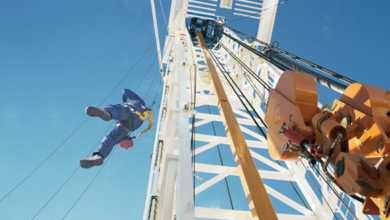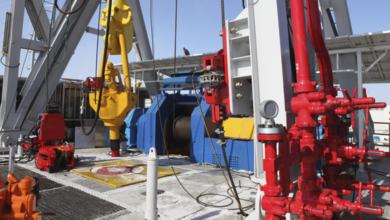D&C Tech Digest
First injection of water achieved in Shell’s Ursa/Princess Waterflood project in GOM
Shell announced it has achieved another milestone in the Ursa/Princess Waterflood project. First injection of water occurred on 3 July 2008 and is planned to continue for the next 30 years. With a listed volume enhancement capacity of 30,000 bbl/day of oil equivalent, the waterflood is expected to extend the life of the field by 10 years.
“The Ursa/Princess Waterflood project represents a significant investment by Shell and the other interest owners in one of the most prolific areas in the Gulf of Mexico — the Ursa-Mars basin. Ursa-Princess has produced nearly 400 million bbl of oil equivalent to date, and we believe potential exists for continued development of material oil and natural gas within this basin,” said Russ Ford, vice president technical, Shell Americas.
The Ursa/Princess Waterflood is one of the largest construction projects on an existing platform in the Gulf of Mexico. This presented challenges of very high activity levels and simultaneous construction, commissioning, maintenance and well servicing activities, while performing production operations on a large facility located 100 miles offshore. The relentless focus on hazard management and emphasis on reducing risk exposure resulted in strong safety performance over the entire project.
Waterflood is a method of secondary recovery in which water is injected into the reservoir formation to displace additional oil. The water from injection wells re-pressurizes the formation and physically sweeps the displaced oil to adjacent production wells. The Ursa/Princess Waterflood topsides injection system injects filtered and treated sea water via two separate flowlines to three subsea sites – one to an existing well site northwest of the Ursa Tension Leg Platform (TLP), one to an existing well site southeast of the Ursa TLP and one to a new well site northeast of the Ursa TLP. Producing wells will include three Princess subsea wells and as many as six Ursa TLP wells.
Ursa is located in 3,800 ft of water and encompasses Mississippi Canyon Blocks 808, 809, 810, 852, 853 and 854. Princess is located in Mississippi Canyon Blocks 765 and 766, in approximately 3,650 ft of water.
Shell is operator of this project with 45.39%; BP has 22.69%; Exxon Mobil and ConocoPhillips each have 15.96%.
VetcoGray converts mudline exploration system to wellhead subsea system
VetcoGray, a GE Oil & Gas business, applied its latest technology to convert an exploration well to full production service at Agiba Petroleum’s West Ashrafi hydrocarbon facility in Egypt’s Gulf of Suez, Red Sea. The project marks the first time that VetcoGray has converted a mudline exploration system to an SG-1 wellhead subsea system for production duty. The newly converted well entered service in April 2008.
“The new conversion system removed the need for Agiba Petroleum to re-enter the reservoir from a new wellhead, as this had proven difficult during the exploration phase. This solution therefore removed significant cost and risk from the project,” said Willie Bryson, VetcoGray’s product line manager for Tree on Mudline.
“When the West Ashrafi well conversion was first envisioned, a number of technical challenges were identified that could have affected the viability of the project,” he added. VetcoGray and Agiba worked together to complete a feasibility study, which concluded that all of the challenges could be overcome. VetcoGray subsequently executed the engineering and construction of the conversion system.
Additional challenges for the project included the distance between the beach-mounted topside equipment (umbilical termination and hydraulic power units) and the master control station, which was located 1 km away. A separate communications and power system was used to achieve the subsea communications, while fiber optic communications were utilized between the HPU/TUTU and the MCS.
2 million-plus ft of inflow control completions system installed
Baker Oil Tools (BOT) has installed more than two million ft (609,600 m) of inflow control completion systems to achieve successful production rates in horizontal wells in more than 20 oil and gas fields around the world. The EQUALIZER Reservoir Optimized Completion System has helped maximize hydrocarbon recovery for numerous worldwide operators, according to Brad Baker, director of sand control systems for BOT.
“We are very proud of reaching two million feet in ground with no reported sand control problems. This outstanding track record is made possible through strategic project management and the application of advanced technology – an extended-longevity well screen and a specially designed inflow control device,” Mr Baker said.
“Optimal reservoir drainage presents a growing challenge when producing from extended-reach horizontal and multilateral wellbores, even in formations with uniform permeability,” he explained. “When alternating high- and low-permeability strata are penetrated by a long wellbore, or when high permeability exists at either the heel or toe of a lateral section, the tendency to lose production through various parts of the reservoir becomes even greater.
“Optimal production from long, low-drawdown, high-rate horizontal wells often requires more than sand control, so the EQUALIZER System also provides production optimization,” he said. “The system balances, or equalizes, longitudinal inflow along the entire length of a wellbore. A uniform production profile ensures reduced influx of water or gas into the wellbore.”
To delay water or gas coning in horizontal wells, the system uses an extended-longevity well screen and an inflow control device as a restrictive element. The well screen provides sand control and resists plugging and erosion with three concentric layers of media – a protective shroud, a single-layer vector filtration membrane and an inner jacket.
The outermost layer of the screen is a durable vector shroud that provides erosion protection under turbulent flow conditions. Within the shroud, the single-layer vector membrane has uniform pore throat openings and an inflow area of about 30%, ten times that of a typical pre-pack screen. The inner jacket and drainage layer protects the overlying vector membrane layer against high differential pressure. These features combine to extend screen life to eight times that of a standard pre-pack screen.
The inflow control device uses a restrictor element to distribute pressure along the entire length of a wellbore. This allows local production rates at any point along a wellbore to be controlled as a function of both the average drawdown pressure and the average productivity of a well.
BOT uses operator-supplied formation data to conduct mathematical modeling and to configure individual systems that attain optimal pressure drop and flow rates.
The system is applicable for a variety of wellbore conditions, including those that require viscous fluid, kill pill clean-up, or multiphase flow.
Since 1998, the system has attained individual lateral installation lengths of more than 13,000 ft (4,000 m).
Shell selects Cameron’s MARS technology for first North Sea application
In June 2008, Shell UK successfully installed the first of three subsea MARS (Multiple Application Re-injection System) interfaces on its Bittern field in the North Sea. The system has been described as an “USB port for wellheads” and is being adopted by Shell as part of its extended oil recovery strategy for the region.
Following the commissioning, Shell is now able to complete reservoir stimulation/scale squeeze operations from a ROV support vessel without the need for MODU or diving support. The MARS system is a Cameron technology supplied by DES Operations of Aberdeen.
“Until now, operators have been using MARS for multiphase pumping and metering operations, but this is a world-first for reservoir stimulation,” said Ian Donald, managing director of DES. “For Shell, MARS offers safer, faster and cheaper operations, with options to extend the functionality for further subsea processing operations.”
The remaining two MARS systems are due for installation later this year and, when installed, will enable Shell to undertake multiple well stimulation campaigns from a single ROV vessel.
John Anthony, Shell project manager, said, “We approached DES two years ago to see if their technology could be adapted for our scale squeeze operations, and have worked with DES since then to this successful conclusion.”
In addition to use in the Bittern field, MARS has also been successfully used by BP King in the Gulf of Mexico and has been selected by TOTAL for use in subsea multiphase metering in West Africa.




